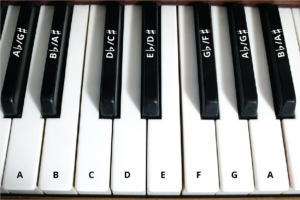Note Values, Half-Steps, Whole Steps, and Octaves
Moving our exploration to note values, the frequency of all notes is well defined by a specific and unique frequency for each note that is measurable. We will explore keys on a keyboard to discuss notes that have the same relationships with any instrument or musical piece.

Let’s look at the figure above. The white keys are labeled with the letters [latex]A–G[/latex] and the photo begins with middle [latex]C[/latex], which can be found in the middle of a keyboard. This labeling of the keys repeats across an entire keyboard and keys to the right have a higher pitch and frequency than keys to the left. Each of the keys correlates to a musical note.
Movement up or down between any two consecutive keys (black and white) or notes constitutes a half-step. Movement of one half-step sometimes involves a sharp ([latex]\#[/latex]) or a flat ([latex]♭[/latex]) symbol. For example, [latex]D^\#[/latex] is one half-step above [latex]D[/latex] and [latex]D^♭[/latex] is one half-step below [latex]D[/latex]. Note that this is not always true as one half-step above [latex]B[/latex] is [latex]C[/latex], and one half-step below [latex]F[/latex] is [latex]E[/latex]. In similar fashion, a whole step is movement up or down between any two half-steps on a keyboard.
half-step, sharp, flat, and whole step
Half-Step: A half-step is the smallest musical interval between two adjacent keys on a keyboard, often denoted by a sharp ([latex]\#[/latex]) or a flat ([latex]♭[/latex]) symbol.
Sharp: A sharp ([latex]\#[/latex]) is a musical symbol that raises the pitch of a note by a half-step.
Flat: A flat ([latex]♭[/latex]) is a musical symbol that lowers the pitch of a note by a half-step.
Whole Step: A whole step is a musical interval that consists of two half-steps, representing a larger distance between notes on a keyboard.
Name which keys are one half-step up and one half-step down from the following:
- [latex]D[/latex]
- [latex]E[/latex]
- [latex]G^\#[/latex]
Name which keys are one whole step up and one whole step down from the following:
- [latex]F^\#[/latex]
- [latex]E[/latex]
- [latex]A^♭[/latex]
You may have noticed that there are eight letters of the alphabet used to label notes. Selecting any one note and counting up [latex]12[/latex] half-steps you will find that the numbering for notes begins at the same value as you started from. This collection of [latex]12[/latex] consecutive half-notes is called an octave and is a basic foundational component in music theory.
octave
An octave serves as a foundational unit in music theory, encompassing 12 half-steps and marking the point where the note names repeat but at a higher pitch.
The octave is significant because it represents a doubling of frequency, creating a harmonious and consonant relationship between the starting and ending notes.
Let’s look at an example.
List the [latex]12[/latex] notes forming an octave, beginning with the note [latex]C[/latex].
Try it yourself.
List the [latex]12[/latex] notes forming an octave, beginning with the note [latex]G[/latex].